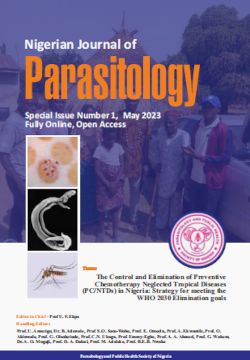Seroprevalence and associated risk factors of human cystic echinococcosis in some parts of Plateau State, Nigeria
http://dx.doi.org/10.4314/njpar.v41i1.5
Keywords:
Seroprevalence, Echinococcus granulosus, antibody, ELISA, human, Plateau StateAbstract
Livestock, pets and companion animals in developing nations are plagued with several infectious diseases some of them with zoonotic potentials. Echinococcosis which is a neglected zoonotic parasitic disease is one of such diseases that affect domestic animals and man with serious health and economic impacts. A cross-sectional questionnaire and serological survey was conducted on human subjects from four Local Government Areas (LGA) of Plateau State, Nigeria, to determine knowledge, attitude and practice and their level of exposure to E. granulosus infection. Sera from 181 human subjects recruited for this study were screened for IgG antibodies to E. granulosus using a commercial ELISA kit. Overall, 6 out of the 181 (3.3%) tested sera were positive. Seropositivity was associated with subjects below 10 years (OR=5.6), study location (OR=1.8), and scavenging behaviour of dogs (OR= 1.5), but not with gender of dog owners (OR=0.7), dog ownership (OR=0.6), dog deworming practice (OR=0.3) or the use of slaughter facility and meat inspection (OR=0.6). Ignorance about the transmission cycle of E. granulosus coupled with unhygienic practices are the main risk factors for the perpetuation of the disease in the study-communities. Sensitization, awareness creation and advocacy for hygienic practises among the communities are recommended, as a short term measure while large scale studies to determine the true prevalence and the risk factors of the disease will form the basis for possible future control measures.
References
Torgerson, P. R. and Budke, C. M. 2003. Echinococcosisan international public health challenge. Research in Veterinary Science, 74(3), 191- 202.
Berger, S. A. and Marr, J. S. 2006. Human parasitic diseases source book. Sudbury, Massachusetts. Publishers, Jones and Bartlett, 537.
Dakkak, A. 2010. Echinococcosis/hydatidosis: A severe threat in Mediterranean countries. Veterinary Parasitology, 174(1-2), 2-11.
Menezes da Silva, A. 2010. Human echinococcosis: A neglected disease. International Association of Hydatidology, Portugal. From http://dx.doi.org/ 10.1155/2010/583297
Craig, P. S., Rogan, M.T. and Allan, J. C. 1996. Detection, screening and community epidemiology of taeniid cestode zoonoses: Cystic echinococcosis, alveolar echinococcosis and neurocysticocosis. Advanced Parasitology, 38, 169-250.
Grosso, G., Gruttadauria, S., Biondi, A., Marventano, S. and Mistretta, A. 2012. Worldwide epidemiology of liver hydatidosis including the Mediterranean area. World Journal Gastroenterology, 18, 1425-1437.
Eckert, J., Schantz, P. M., Gasser, R. B., Torgerson, P. R., Bessonov, A. S., Movsessian, S. O., Thakur, A., Grimm, F. and Nikogossian, M. A. 2001. Geographic distribution and prevalence. In: J. Eckert, M. A. Gemmell, F X. Meslin and Z. Pawloski, (Eds.), WHO/ OIE Manual on Echinococcosis in Humans and Animals: Pulbic Health Problem of Global Concern pp. 100-142. Paris: Office Internal des Epizooties Paris.
Wahlers, K., Menezes, C. N., Wong, M. L., Zeyhle, E., Ahmed, M. E., Ocaido, M., Stijnis, C., Romig, T., Kern, P. and Grobusch, M.P. 2012. Cystic echinococcosis in sub-Saharan Africa. The Lancet Infectious Diseases, 12(11): 871-880.
Budke, C. M., Deplazes, P. and Torgerson, P. R. 2006. Global socioeconomic impact of cystic echinococcosis. Emerging Infectious Disease, 12(2), 296-303.
Dada, B. J. 1980. Taeniasis, cysticercosis and echinococcosis/hydatidosis in Nigeria: IV- Prevalence of Echinococcocus granulosus infection in stray dogs. Journal of Helminthology, 54(4), 299-301.
Adediran, O. A., Kolapo, T. U. and Uwalaka, E. C. 2014. Echinococcus granulosus prevalence in dogs in South West Nigeria. Journal of Parasitology Research, Article ID 124358. http://dx.doi.org/10.1155/2014/124358.
Thrusfield, M. V. 2005. Veterinary Epidemiology (2nd Ed. pp. 183). Blackwell Science, Oxford, U.K.
Macpherson, C. N. 1983. An active intermediate host role for man in the life cycle of Echinococcus granulosus in Turkana, Kenya. The American Society of Tropical Medicine and Hygiene, 32(2), 397-404.
Sotiraki, S., Himonas, C. and Korkoliakou, P. 2003. Hydatidosis-echinococcosis in Greece. Acta Tropica, 85(2): 197-201.
Rokni, M. 2009. Echinococcosis/hydatidossis in Iran. Iran Journal Parasitology, 4(2), 1-11-116.
Rakhshanpour, A., Harandi, M. F. and Moazezi, S. 2012. Seroprevalence of human hydatidosis using ELISA method in Qom Province Central Iran. Iran Journal Parasitology, 7(3), 10.
Hezarjaribi, H. Z., Fakhar, M., Esboei, B, R., Soosaraei, M., Ghorbani, A., Nabyan, N. and Teshnizi, S. H. 2017. Serological evidence of human cystic echinococcosis and associated risk factors among general population in Mazandara Province, Northern Iran. Annals of Medicine and Surgery, 18, 1-5.
Shambesh, M. K. 1997. Human cystic echinococcosis in North Africa (excluding Morocco). In F. L Anderson, H. Ouhelli, M. Kachin (Eds), Compendium on cystic echinococcosis in Africa and in Middle Eastern countries with special reference to Morocco (pp. 223-244). Provo, Utah: Brigham Young University, Print Services.
Siddharth, S. R., Bhupendra, M. and Ravindra, N. 2012. The spectrum of hydatid disease in rural central India: an 11 years experience. Annals of Tropical Medicine and Public Health, 5, 225-230.
Craig, P. S., McManus, D. P., Lightowlers, M. W. Chabalgoity, J. A., Garcia, H. H., Gavidia, C. M., Gilman, R. H., Gonzalez, A. E., Lorca, M., Naquira, C., Nieto, A. and Schantz, P. M. 2007. Prevention and control of cystic echinococcosis. Lancet Infectious Disease, 7, 385-394.
Khalili, A. H., Al-Jeboori, T. I., Munir, R. and Alsammak. M, 1990. Hydatid disease: A comperative study in the medical city teaching hospital after 10 years. College of Medicine Baghdad. Proceedings of Scientific Conference, SRC, Baghdad, 5, 356-364.
Campos-Bueno, A., Lopez-Abente, G. and AndresCercadillo, A. M. 2000. Risk factors for Echinococcus granulosus infection: A case-contrl study. American Journal of Tropical Medicine and Hygiene, 62(3), 329- 334.
Liu, P., Cai, J. S., Li, J. H. and Kang, J. L. 2016. Pilot survey on prevention and control of echinococcus in Qinghai Province. China AHI, 33, 79.
Downloads
Published
How to Cite
Issue
Section
License
Copyright (c) 2023 Nigerian Journal of Parasitology

This work is licensed under a Creative Commons Attribution-NonCommercial-NoDerivatives 4.0 International License.





